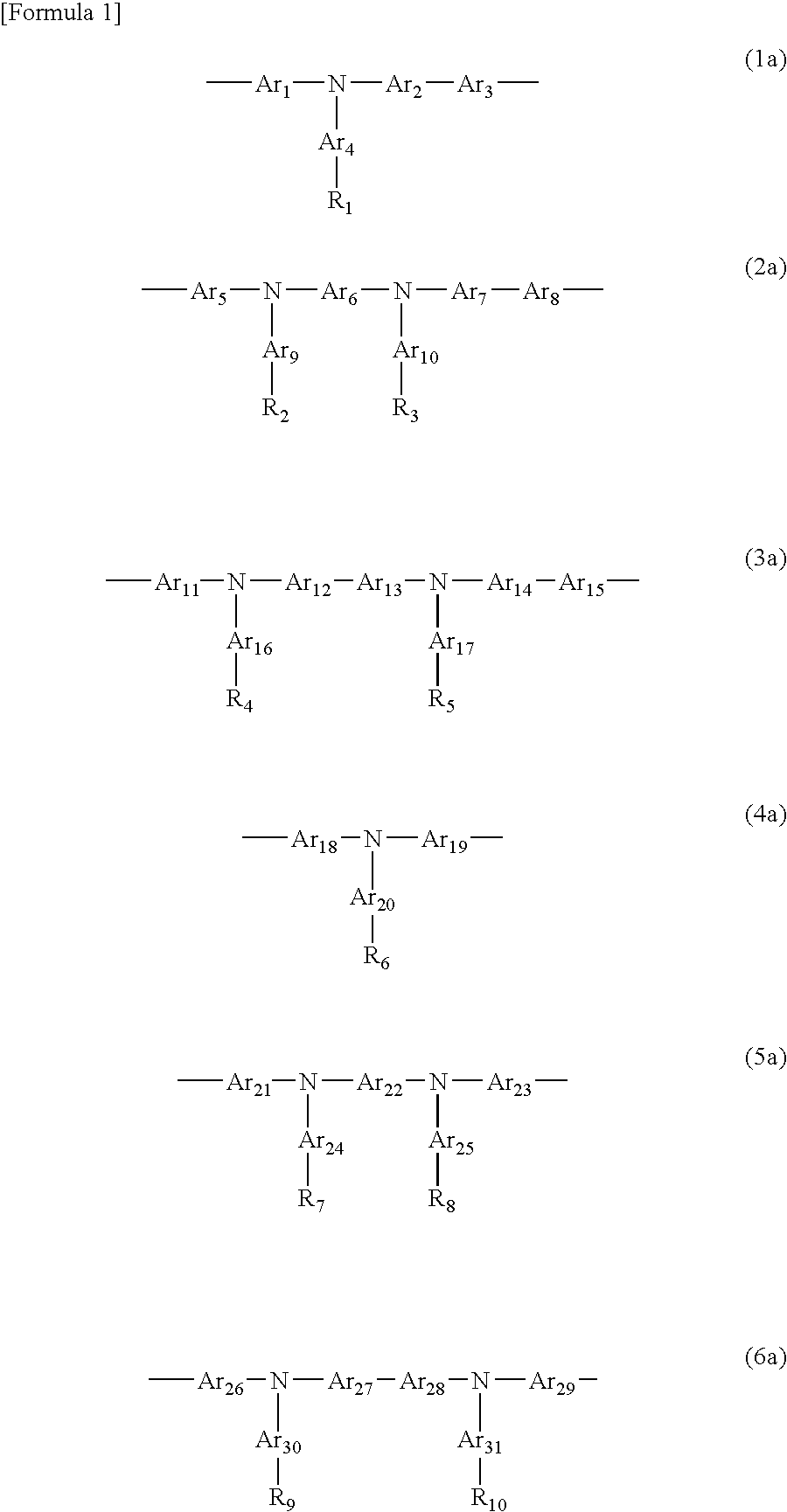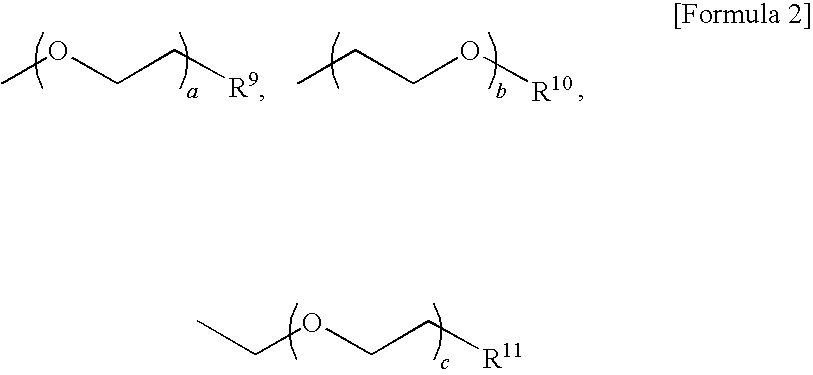Organic electronic material, organic electronic device, and organic electroluminescent device
- Summary
- Abstract
- Description
- Claims
- Application Information
AI Technical Summary
Benefits of technology
Problems solved by technology
Method used
Image
Examples
synthesis example 1
Monomer Synthesis Example 1
[0099]
[0100]3-ethyl-3-hydroxymethyloxetane (50 mmol), 4-bromobenzyl bromide (50 mmol), n-hexane (200 mL), tetrabutylammonium bromide (2.5 mmol), and 50 weight % aqueous sodium hydroxide solution (36 g) were introduced into a roundbottom flask and were stirred for 6 hours under nitrogen while heating to 70° C. After cooling to room temperature (25° C.), 200 mL water was added and extraction with n-hexane was carried out. After the solvent had been distilled off, purification by silica gel column chromatography and vacuum distillation yielded 9.51 g polymerizable substituent-containing monomer A as a colorless oil. Yield=67 weight %. 1H—NMR (300 MHz, CDCl3, δ ppm): 0.86 (t, J=7.5 Hz, 3H), 1.76 (t, J=7.5 Hz, 2H), 3.57 (s, 2H), 4.39 (d, J=5.7 Hz, 2H), 4.45 (d, J=5.7 Hz, 2H), 4.51 (s, 2H), 7.22 (d, J=8.4 Hz, 2H), 7.47 (d, J=8.4 Hz, 2H). The 1H—NMR spectrum of polymerizable substituent-containing monomer A is shown in FIG. 2.
synthesis example 2
Monomer Synthesis Example 2
[0101]
[0102]3-ethyl-3-hydroxymethyloxetane (5 mmol), 3,5-bromobenzyl bromide (5 mmol), n-hexane (20 mL), tetrabutylammonium bromide (0.25 mmol), and 50 weight % aqueous sodium hydroxide solution (3.6 g) were introduced into a roundbottom flask and were stirred for 6 hours under nitrogen while heating to 70° C. After cooling to room temperature (25° C.), 20 mL water was added and extraction with toluene was carried out. After the solvent had been distilled off, purification by silica gel column chromatography yielded 1.75 g polymerizable substituent-containing monomer B as a colorless solid. Yield=96 weight %. 1H—NMR (300 MHz, CDCl3, δ ppm): 0.88 (t, J=7.5 Hz, 3H), 1.78 (t, J=7.5 Hz, 2H), 3.59 (s, 2H), 4.40 (d, J=5.7 Hz, 2H), 4.48 (d, J=5.7 Hz, 2H), 4.49 (s, 2H), 7.41 (m, 2H), 7.59 (m, 1H). The 1H—NMR spectrum of polymerizable substituent-containing monomer B is shown in FIG. 3.
[0103]
Oligomer Synthesis Example 1
[0104]
[0105]2,7-bis(4,4,5,5-tetramethyl-1,3,2-...
example 1
[0124]A PEDOT:PSS dispersion (CH8000 LVW233 from Starck·Vtech) was spin-coated at 4000 rpm onto a glass substrate patterned with ITO at a width of 1.6 mm followed by drying by heating for 10 minutes at 200° C. in air on a hot plate to form a hole injection layer (40 nm). The following experiment was then carried out under a dry nitrogen atmosphere.
[0125]A coating solution obtained by mixing the oligomer A (4.4 mg) obtained in Oligomer Synthesis Example 1, a photoinitiator (0.13 mg) with the following chemical formula,
and toluene (1.2 mL) was then spin-coated at 3000 rpm on the hole injection layer, followed by curing by exposure to light (3 J / cm2) using a metal halide lamp and heating for 60 minutes at 180° C. on a hot plate to form a hole transport layer (40 nm)
[0126]A toluene solution (1.5 weight %) of the yellow-emitting polymer obtained in the preceding light-emitting polymer synthesis example was then spin-coated at 3000 rpm on the hole transport layer followed by heating for 5...
PUM
| Property | Measurement | Unit |
|---|---|---|
| Molecular weight | aaaaa | aaaaa |
| Transport properties | aaaaa | aaaaa |
| Polydispersity index | aaaaa | aaaaa |
Abstract
Description
Claims
Application Information
 Login to View More
Login to View More - R&D
- Intellectual Property
- Life Sciences
- Materials
- Tech Scout
- Unparalleled Data Quality
- Higher Quality Content
- 60% Fewer Hallucinations
Browse by: Latest US Patents, China's latest patents, Technical Efficacy Thesaurus, Application Domain, Technology Topic, Popular Technical Reports.
© 2025 PatSnap. All rights reserved.Legal|Privacy policy|Modern Slavery Act Transparency Statement|Sitemap|About US| Contact US: help@patsnap.com



